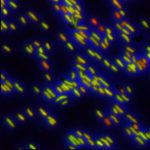Link to Pubmed [PMID] – 34235654
Link to DOI – 10.1007/978-1-0716-1460-0_8
Methods Mol Biol 2021 ; 2314(): 205-229
Studies on cell-to-cell phenotypic variation in microbial populations, with individuals sharing the same genetic background, provide insights not only on bacterial behavior but also on the adaptive spectrum of the population. Phenotypic variation is an innate property of microbial populations, and this can be further amplified under stressful conditions, providing a fitness advantage. Furthermore, phenotypic variation may also precede a latter step of genetic-based diversification, resulting in the transmission of the most beneficial phenotype to the progeny. While population-wide studies provide a measure of the collective average behavior, single-cell studies, which have expanded over the last decade, delve into the behavior of smaller subpopulations that would otherwise remain concealed. In this chapter, we describe approaches to carry out spatiotemporal analysis of individual mycobacterial cells using time-lapse microscopy. Our method encompasses the fabrication of a microfluidic device; the assembly of a microfluidic system suitable for long-term imaging of mycobacteria; and the quantitative analysis of single-cell behavior under varying growth conditions. Phenotypic variation is conceivably associated to the resilience and endurance of mycobacterial cells. Therefore, shedding light on the dynamics of this phenomenon, on the transience or stability of the given phenotype, on its molecular bases and its functional consequences, offers new scope for intervention.

